Iraq's Water Crisis
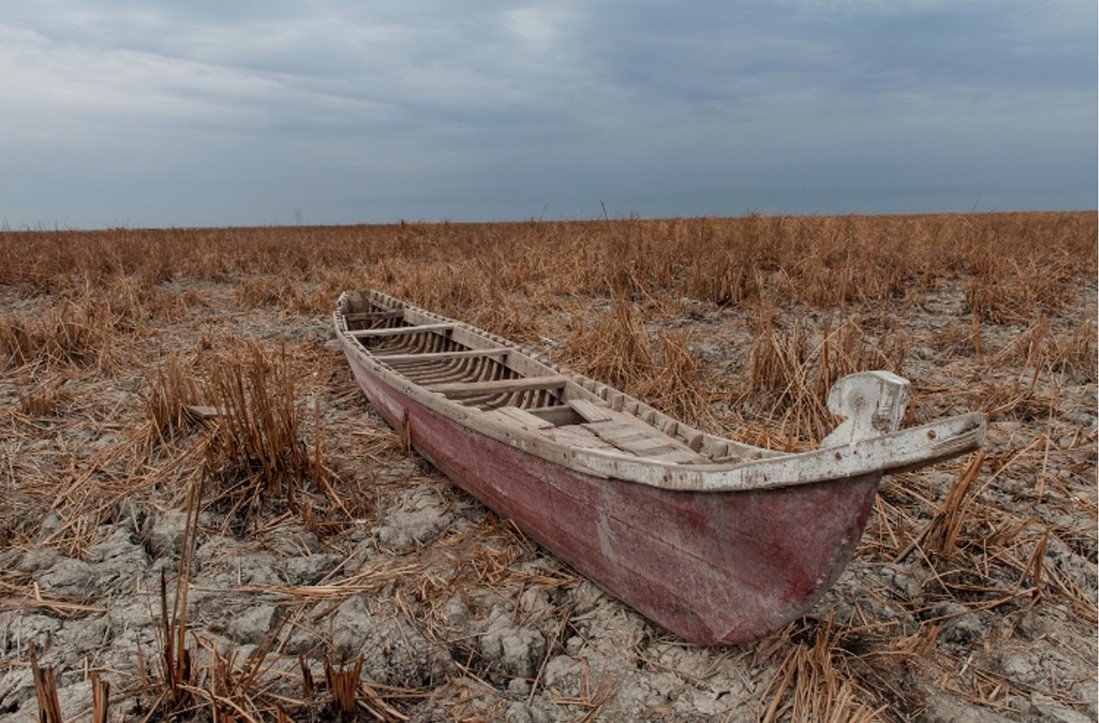

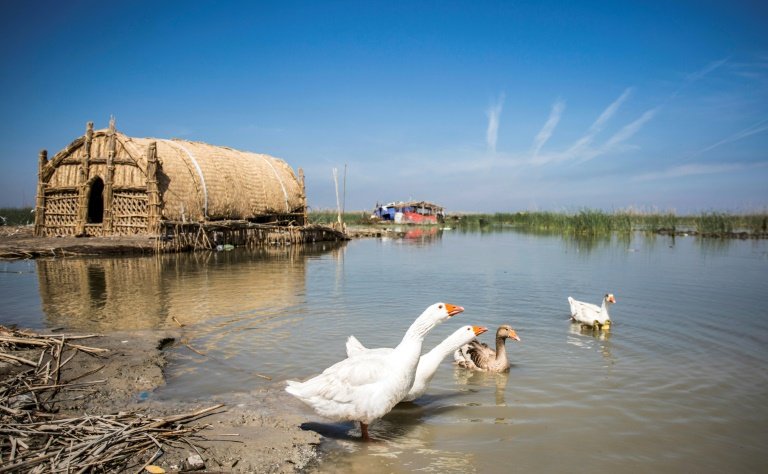
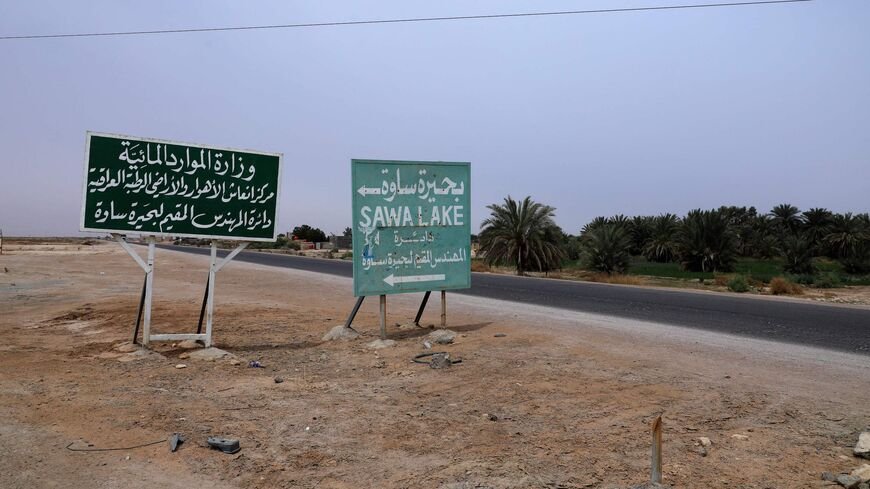


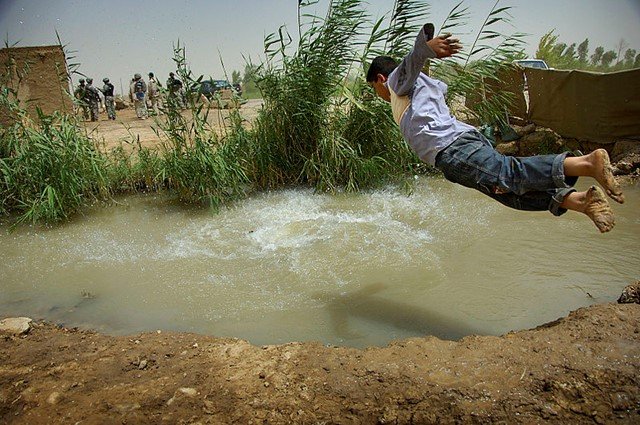
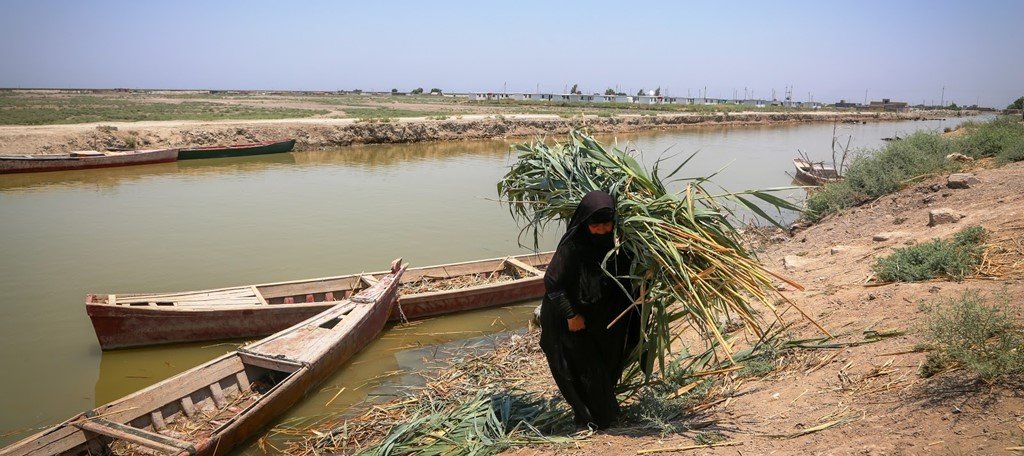
By Dr. Adhid Miri
Water is life, and life exists because of water. As a chemist and also an Iraqi, the H2O molecule has a special meaning for me. Iraq, where water used to be abundant, is facing an incredible crisis. This article examines the impact of climate change on water resources and the ensuing economic and political challenges in the Euphrates-Tigris basin shared by the countries of Iraq, Iran, Syria, and Turkey.
Known as “the land between the two rivers,” Iraq has enjoyed access to plentiful water since the dawn of civilization; however, most of Iraq’s water supply either originates from or passes through neighboring countries.
Iraq’s main sources of water are the Tigris and the Euphrates Rivers, providing 98% of the country’s surface water. Both rivers originate in Turkey while the Euphrates passes through Syria and some tributaries flow through Iran. Both the Tigris and Euphrates have dropped to precariously low levels, creating consequences such as public health concerns, decreased agricultural productivity, and political unrest.
Alongside rivers, groundwater is Iraq’s second most important supply of water, albeit underutilized. Unfortunately, in the future groundwater is expected to decline significantly due to increased salinization.
The water policies of Turkey and Iran have reduced Iraq’s water supply, affecting agriculture and increasing water pollution in most areas of the country. In addition, Iraq’s rising population, government mismanagement of water, and climate change also affect Iraqis’ access to water. The current trends do not bode well for the country’s water security.
Iraq’s extreme vulnerability to climate change can be seen in the rapidly declining rainfall rates, which have fallen 25% to 65% below normal levels, leading to prolonged drought periods. Iraq is also experiencing its second driest season in 40 years due to record low rainfall. Since the 1980s, water flows from the Euphrates and Tigris Rivers have decreased by 30%. This water flow is expected to decline even further, by 50% (Euphrates) and 25% (Tigris) by 2025.
Adding to the problem is the construction of dams, reservoirs, and irrigation projects by Iraq’s upstream neighboring countries, Turkey and Iran. The question of dams and their impact on downstream regions is a vital one in Iraq and Iran, where the Tigris and its tributaries are an economic lifeline in an arid region.
The UN Environment Program reported in 2018 that Iraq was losing around 25,000 hectares of arable land annually.
The article focuses on three different risks that are affected through climate-related water challenges: livelihoods and food security; political stability and violence; and international conflict and cooperation.
The Impact of Climate Change
Iraq is listed among the countries most prone to climate change. Temperatures there have risen significantly and following three years of drought, the rains did not fall at all in the provinces this year. The country needs several seasons of abundant rainfall which it is unlikely to receive.
Of key importance to the future of Iraq is dealing with water scarcity and the degradation of water quality in its rivers and groundwater. The new Economic Monitor’s special focus calls for dramatic sector reforms to capture opportunities and manage risks. A fall of 20% in Iraq’s water supply and the related declining crop yields that accompany climate change could reduce real GDP in Iraq by up to 4%, or $6.6 billion in US dollars.
According to the Iraqi government, average annual rainfall has become less predictable since the 1970s and has decreased by 10% in the last 20 years. Scholars estimate that by 2050 precipitation will decrease by 25% in Iraq, which will intensify desertification. Iraq relies on flood management in agricultural areas and has built several dams to protect large cities from flooding, which unfortunately makes water more susceptible to evaporation.
This decrease in water supply has been compounded by a steep rise in the population in the past few decades. By the end of 2020, Iraq’s population surpassed 40 million, although the rate of growth has declined in the past 10 years.
At the same time, the Iraqi government has subsidized the price of water, leading to overconsumption and waste by Iraqi citizens. Iraqis consume 392 liters per capita daily, while the international average is 200 liters per capita. Without reform in water pricing, overconsumption and undersupply will almost certainly continue.
One in five Iraqis is employed in the farming industry. The water crisis has left many without an income and has forced others to find work elsewhere. This affects not only the farmers but the thousands of Iraqis who rely on the food they produce.
Canals branching out of the Tigris which are typically used to water rice, wheat, and barley fields have run dry, leaving fields barren. In a country where an estimated fifth of the population participates in agriculture, this has been particularly devastating. Some farmers have been reduced from cultivating 60 hectares of land to five. In fact, the water crisis in Iraq prompted the government to suspend rice farming entirely.
If Iraqis have access to water, it is often unsafe for consumption. Basra, a governorate of approximately 4 million people, has been hit hard by the water crisis. The region has suffered from a lack of reliable clean drinking water for the past 30 years, relying mostly on the Shatt al-Arab River and its smaller canals for water; however, upstream damming has diverted river water for use on sugar plantations and other agricultural projects. This combined with decades of decreasing rainfall levels has created a severe lack of clean water in Basra. 120,000 residents required hospital treatment in just one year due to contaminated water. According to the organization Human Rights Watch, the Iraqi government often fails to warn citizens about the dangers and presence of poor water quality.
Many Iraqis are dissatisfied with the government due to the water crisis. They believe that Iraq’s government should have done more to protect water security by building dams of their own. In a country racked by instability and violence, recent protests over the government’s mishandling of water left nine dead, hundreds injured and many more detained in prison.
Compounding the problem, mismanagement and corruption have derailed promised government projects to improve water quality. Authorities have also failed to provide residents with adequate information to protect themselves in the event of a future crisis that experts say is inevitable. These combined failures violate Basra residents’ right to water, sanitation, health, information, a healthy environment, and property (land and crops) guaranteed under international law as well as national law.
Turkey and Iran’s Water Squeeze
Perhaps the most complicated challenge is the role that Iran and Turkey play in siphoning Iraqi water flow. Iraq was considered a water-rich country until the 1970s, when Turkey began building dams, significantly decreasing Iraq’s water supply. The Turkish government initiated the Southeastern Anatolia Project, building 22 dams and 19 hydraulic power plants for developing southeastern provinces. They have been unwilling to negotiate an agreement with Iraq and Syria regarding water allocation.
While decreasing Iraq’s water supply overall, Turkey can also cut the water flow downstream on short notice. For example, in the 1990s, Turkey increased the water level in the Ataturk dam without notifying Syria and Iraq.
Turkey, now roughly fifty years into its dam-building project, has begun power production from its newly constructed Ilisu Dam, one of the largest in the country, giving the Turkish government significant control over water flow on the Tigris River. This is in addition to dams on the Euphrates in Syria and Turkey.
Turkey’s ongoing dam projects have received considerable press coverage and their effects on Iraq may be greater from a purely hydrological perspective; however, Iran’s projects are particularly notable for the ways in which they entangle the two countries’ relations. These projects indicate political dynamics within Iran that are also likely to have an impact on Iraq’s future as Iraq’s current prime minister seeks to navigate through what he has recently called a “tightrope between U.S. and Iranian interests.”
Iran’s domestic water policies are largely the source of crisis developments on the Sirwan (Deyala) and Little Zab Rivers. The country lacks a comprehensive water policy, but the Iranian government claims official ownership over all the country’s waters, with local people entitled to priority for use.
With 600 dams built in Iran and more planned, the waters of rivers such as the Karun and Karkheh have been diverted to stay within Iranian territory and no longer flow into Iraq. These diversions have not only decreased the water flow to Iraq but have also increased salinity.
Recent talks between Iraq and Iran have addressed issues over dredging the Shatt Al-Arab waterway, which defines the southernmost section of the Iran-Iraq border. It is unclear whether the two countries can reach agreements about other waterways like the Sirwan and the Little Zab. Iran has demonstrated, through its delivery of water to Iraqis in Basra, and its continued support for destabilizing militant factions in Iraq, that an ordered, legally binding agreement is not as useful to its regional vision as is the exploitation of turmoil in Iraq.
The geological engineering of land and political manipulation of water resources are likely to have negative effects both up and downstream. Iran has called on Iraq to irrigate and manage dry regions of the country where they claim desertification has produced newly intensified sandstorms that blow into Iran, polluting its own water supplies.
Acute water shortages in Iraq threaten to increase security concerns by impoverishing rural communities, increasing population growth in urban slums, and providing fertile grounds for recruitment into Salafi jihadist organizations like the Islamic State.
The Iraqi government threatened to internationalize the water crisis by submitting a formal complaint to the United Nations if Iran continues to limit the water. However, the government did not follow through and failed to formulate any viable alternative options for dealing with Iran or Turkey.
Mismanagement and Internal Conflict
The deteriorating quality and declining availability of water in Iraq no doubt has adverse effects on the Iraqi people. The United Nations International Organization for Migration reported in 2019 that 21,314 Iraqis had been internally displaced in Iraq’s southern and central governorates due to lack of potable water. Moreover, Iraqi President Barham Salih warned that Iraq might face a deficit of 10.8 billion cubic meters of water annually by 2035 and that 54% of Iraq’s arable land is under threat because of increased salination.
Although agriculture contributes less than 5% of gross domestic product, it employs nearly one-third of Iraqis who live in rural areas. Iraq’s agricultural sector will face a severe blow in the future because of decreased water levels.
Given this pressure, tension between tribes over water is on the rise. The lack of water in southern governorates such as Maysan and Dhi Qar (Nassiriyah) and recurrence of droughts are the main drivers of local conflict. The United Nations reported in 2013 that nearly daily incidents of confrontations, including clashes or verbal arguments, were recorded in 38 locations in Baghdad alone. And there have been water-related conflicts among Arabs, Kurds, and Turkmen in Kirkuk.
There has been contention at the provisional level as well. Officials from Maysan and Muthanna governorates have expressed their discontent toward governorates to their north, saying they were taking more than their share of water.
Iraqis have tried to leverage their control over the water supply domestically. The Kurdistan Regional Government (KRG), which lies in the north and controls much of the water flow to other parts of Iraq, threatened to reduce the water supply over political disagreements with the central government in Baghdad in 2016. The KRG also cut the flow of water to Arab governorates after Iran reduced the water supply to the Little Zab River in 2018.
Despite the gravity of the situation, the Iraqi government’s response to the water crisis has been modest because of inherent weakness and limited solutions. Numerous domestic problems have taken the government’s attention away from formulating a viable strategy to address water shortages. The focus of the Iraqi government over the past two decades has been fighting terrorism, dealing with strong militias allied with Iran, and tackling corruption, thus neglecting other priorities. For example, Iraq has lagged in the agricultural sector, and the government has not done enough to modernize irrigation methods.
Depleted flows in the Sirwan are now affecting over 8,000 acres of farmland in the Sulaymaniyah Governorate alone. Aside from irrigation, it is possible that drinking water in towns like Qalat Daza and Raniyah in Sulaymaniyah Province will be threatened.
Death of a Lake
The Mesopotamian marshlands in southern Iraq were once the largest wetland ecosystem in Western Eurasia. But after years of drought and political turmoil, they are in danger of disappearing.
Iraq’s Lake Sawa is no longer a lake. It has completely dried up; this unique water spot that was located in the middle of the arid Muthanna Desert for thousands of years has disappeared. Iraqis called the salty lake the “Pearl of the South,” and its water contained minerals used for medicinal purposes. The Muthanna Province has seen 3 years of drought, which significantly contributed to the lake’s disappearance.
Lake Sawa existed in a closed basin, meaning it wasn’t fed by any river or stream, which explains a rise in salt concentration and encroaching sandstorms detrimental to the lake’s existence. For centuries the lake was home to at least 31 bird species including gray heron and ferruginous duck, and a hub for fishing and recreation. Until the 1990s the water level of the lake was normal, and the lake turned into a tourist facility for the people of the governorate. Now left in its place is cracked soil and a dry lakebed with a small pond in the middle. Abandoned hotels and tourist facilities speckle the shoreline.
The Ramsar Convention on Wetlands, a global treaty, recognized Sawa as “unique ... because it is a closed water body in an area of sabkha (salt flat) with no inlet or outlet. The lake is formed over limestone rock and is isolated by gypsum barriers surrounding the lake; its water chemistry is unique,” says the convention’s website.
Sawa is not the only body of water in Iraq facing the perils of drought. Other dead water reserves in the last two years include Lake Hemrin and the Abou Zarag Marshes. UNESCO listed the Howeiza Marshes in the Shia’a south and Razzaza Lake in the central province of Karbala as other endangered landmarks. The marshes and the lake are a stopover for migratory birds. This expanse of water was once home to several globally vulnerable species such as the eastern imperial eagle, houbara bustard and marbled duck. Hundreds of families used to rely on fishing the Razzaza for their livelihood. Now the number of dead fish that turns up is bigger than the number of live fish they can catch.
With the death of Lake Sawa, Iraq lost a cultural landmark, a rare environmental and biodiverse area that was once rich in fish, marine animals, and migratory birds. A former school instructor from the area sums up the eco-system disaster: “I am 60 years old, and I grew up with the lake. I thought I would disappear before it, but unfortunately, it has died before me.”
The Solution
Climate change and development in the Euphrates -Tigris basin is a 21st century challenge for Middle Eastern countries. No easy solution for the water crisis in Iraq exists. Progress will require international cooperation and dialogue to address the Syrian and Turkish dams that starve Iraqi portions of the Tigris and Euphrates. Iraq is also in desperate need of aid to build its own water infrastructure.
In July 2019, Turkey published a detailed report regarding its plan to assist Iraq through the crisis. Turkey plans to take three critical steps to alleviate the strain placed on its southern neighbor: They will allow more water to flow into Iraq from the Tigris and the Euphrates; to help rebuild infrastructure, Turkey will provide financial aid.; and finally, they promise to train Iraqi engineers and technical personnel on wastewater treatment and hydrology.
Although the water crisis in Iraq seems dire, steps are already being taken to rectify it. UNESCO is partnering with the Iraqi government to reform the water management sector and improve irrigation systems.
The agency is assisting the Ministry of Water Resources’ efforts to expand the capabilities of water management experts, strengthen the institutions which impact water resource management, and create a national policy for water sustainability.
Additionally, UNESCO addressed the water crisis in Iraq through improvements to irrigation systems, often utilizing ancient methods that have existed in the region for millennia. In the northern Kurdish governorates, for instance, UNESCO has worked to restore the Kariz (Qanat-Canal) system, an ancient method of providing drinking water and agricultural irrigation.
The agency is also collaborating with officials in the Kurdistan Regional Government to train workers in the water management field and provide hydrological testing equipment.
Conclusion
Seven million people in Iraq are at risk because of a lack of water and the crisis is only intensifying. Political divisions and corruption within successive Iraqi governments as well as social divisions in Iraq have contributed to the neglect of important issues such as water.
To reverse or at least halt the current negative trends the Iraqi government will need not only to come to an agreement with its much stronger neighbors over water rights, but also to commit to a long process of major domestic political, economic, and social reforms, including water use and pricing.
Time is running out. Long-term solutions to Iraq’s water challenges are less than clear and time is not on its side. If action is not taken today, we may live to see the death of the Tigris and Euphrates.
Additional sources: Wikipedia, articles by Hamza Shareef, Massaab Al-Aloosy, Nabeel Darweesh, Ashraf Al-Saeed, Mustapha Mohammed Gharib, Clarissa Cooney, Kyle Linder, Al-Sumaria news, the Cascade project report. Special editing by Jacqueline Raxter and Rand Isaq.
